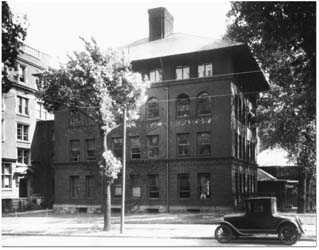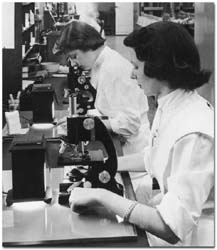![]()
The William Pepper Laboratory of Clinical Medicine, 36th and Spruce Streets, built 1895. As designed, laboratories for microscopic, chemical and bacteriological investigations on patient specimens occupied the first floor of the four-story brick building. The second floor housed a laboratory for anthropometry and the director's office. Post-graduates utilized a third-floor laboratory, while a special laboratory, meeting room and library comprised the fourth floor. Notably, corridors connected the first three floors with the adjacent University Hospital building, facilitating the Pepper Lab's role as the hospital's center for all laboratory testing. The 1895 building was demolished in 1928 to make way for the larger Martin Maloney Memorial Clinic in which the Laboratory occupied two floors. (University of Pennsylvania Archives)
Student medical technologists in Penn's School of Allied Medical Professions (SAMP) learning bacteriological and serological techniques, circa 1955. As part of its educational mission within an academic medical center, the William Pepper Laboratory supported hands-on training of students matriculated in SAMP's Division of Medical Technology. Many schools of medical technology, including SAMP, closed in the late 20th century, much to the detriment of clinical laboratories. However, medical technologists continue to play a critical role in running modern clinical microbiology laboratories. (University of Pennsylvania Archives)

